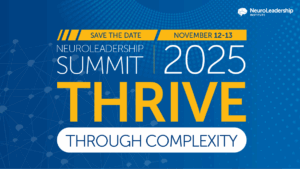Email notifications. Text messages. Chat alerts. Random questions from coworkers. Impromptu meetings. The average workday is awash in modern distractions, most of them digital in nature.
While seemingly benign on an individual level, research suggests these small losses in productivity can add up to a distracted organization — one that is slower to adapt to change, less creative, and falls short of its revenue potential.
The key, says NeuroLeadership Institute CEO Dr. David Rock, is to build in moments of quiet.
“Our ‘Aha moments’ are literally quiet brain signals,” Dr. Rock recently told The New York Times.
Why insights matter
These “Aha moments,” or insights, as NLI calls them, are vital for personal and organizational transformation because they enable breakthroughs. They enable new ways of thinking and working through familiar challenges. In addition, insights are intensely motivating. People feel more compelled to adopt new habits, our research has shown, when they have stronger insights.
Unfortunately, today’s employees — with near constant demands to collaborate and stretch thin — rarely get the time to stop and think.
“You wouldn’t expect someone to do a physical task like chop wood for hours on end with no break,” Dr. Rock told the Times. “It’s similar with the brain.” Knowledge workers, the cognitive lumberjacks that they are, also need to productively pause, allowing quiet signals to emerge into fresh ideas.
Insights are especially important as so many organizations embrace digital transformation. Leaders and employees alike must have the time to think not only about internal challenges, but also those out in the market. They must ask themselves big Why questions, such as Why are we making what we make? and Why are we doing things this way? The exercise helps organizations ensure they explore each course of action at their disposal.
The way modern work gets done rarely affords people this opportunity. Teams stay mired in the details and may charge ahead without considering where the tides are turning.
How to create the conditions for insight
NLI calls on leaders to embrace the science of insight through their own behaviors. Psychology research has found leaders wield a great deal of power in the habits they engrain in the culture, due to a phenomenon known as “goal contagion.” Simply put, employees tend to take their cues from what leadership is doing.
If leaders execute nonstop and don’t build in time for insight, employees aren’t likely to do so for themselves. On the other hand, if leaders make insight an explicit priority, they can help their teams see the value, too.
In practice, facilitating insight looks like built-in breaks for reflection. (Dr. Rock says 15 minutes of quiet time for every 45 minutes of work tends to strike a good balance for him.) When employees have these opportunities, NLI believes organizations will make more effective decisions in less time.
Of course, insight alone won’t help leaders carry out transformation — inclusion, decision-making strategies, and execution approaches also play key roles. But without generating new knowledge, organizations can’t expect much transformation to take place.






